Shea Butter Benefits: 28 Amazing Uses For Skin, Hair & Health
From moisturizing the skin to treating acne and blemishes, this butter has a lot to offer.
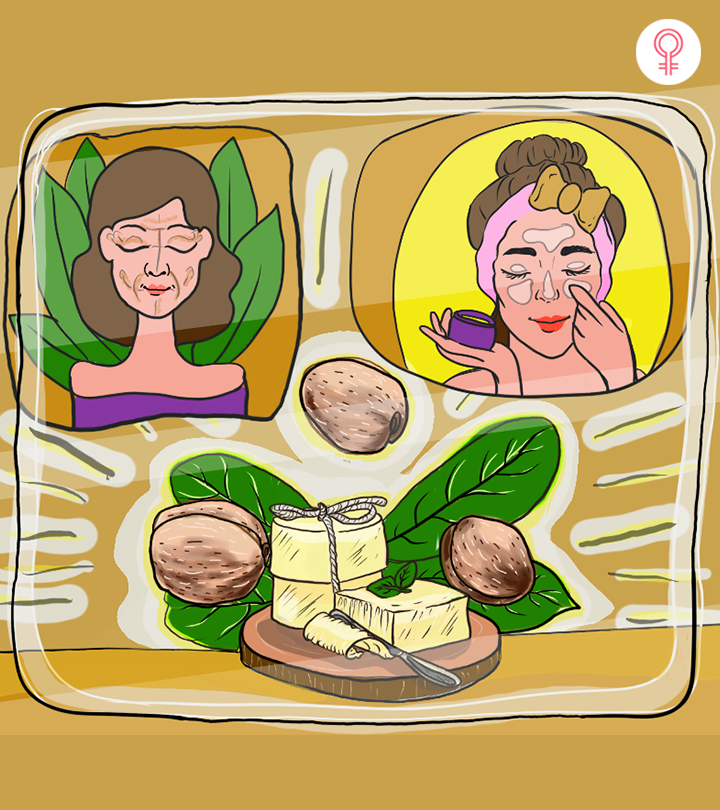
Image: StyleCraze Design Team
An oil rich in fats that is derived from the karite tree (also known as the shea tree) is your solution for many skin, health, and hair health issues.
Fairly recently, this butter has gained huge popularity in the western world due to its widespread use in several beauty products, such as lotions, cosmetics, shampoos, and conditioners. Let’s learn more about shea butter benefits, nutrition facts and much more.
If you are looking to find a great natural beauty product for your skin or hair, then shea butter is a wonderful choice. Read on!
 Know Your Ingredient: Shea Butter
Know Your Ingredient: Shea ButterWhat Is It?
It is a seed fat oil that exists as a solid at room temperature and is derived from nuts of the African shea tree.
What Are Its Benefits?
It has anti-inflammatory properties that may moisturize dry and itchy skin and soothe chapped lips, It may also relieve muscle aches, and nasal congestion and even repair damaged hair.
Who Can Use It?
It is safe to consume as a substitute for cooking oil and can even be topically applied, however, individuals with latex allergy should avoid it.
How Often?
You can consume it daily but in moderation.
Caution
It may cause side effects like itchy rashes, nausea, dizziness or abdominal pain.
In This Article
What Is Shea Butter?
Extracted from the nuts of the shea tree (Vitellaria paradoxa) that is native to Africa, shea butter is a fatty oil that exists as a solid at room temperature.
The Karite tree bears the fruits, and the nuts inside the fruits are of prime importance. These nuts are crushed, boiled, and manipulated to extract a light-colored fat, which is commonly referred to as shea butter.
The main components of shea butter include oleic acid, stearic acid, linoleic acid, etc. It gets absorbed quickly into the skin as it melts at body temperature. Its moisturizing and healing properties prove beneficial for many skin issues. It also has anti-inflammatory and antimicrobial properties (to a certain extent) that can be utilized to treat many ailments. Its similarity to many vegetable oils makes it suitable for ingestion (1).
Global Shea Butter Usage In Cosmetics
The increasing use of shea butter in cosmetics has boosted its market value and popularity among consumers. According to one market research survey, the market size of shea butter is estimated to increase by approximately 1638 million dollars within four years (2026). Check out the graph below to further understand the market size of cosmetic-grade shea butter.
Global Shea Butter Usage In Cosmetics
Source: Transparency Market ResearchLet’s look at the history of this rich nut butter before we delve into its beneficial properties and nutrition facts.
Key Takeaways
- Shea butter is rich in vitamins, fatty acids, and other nutrients that moisturize the skin.
- It provides relief to itchy skin as it has soothing and anti-inflammatory properties.
- It can deep-condition dry and damaged hair to improve its texture and shine.
- Shea butter can be used as a natural sunblock to protect your skin against UV rays.
History Of Shea Butter
The shea tree has naturally inhabited West Africa for centuries, stretching from Senegal to Sudan and up to the foothills of Ethiopia. African history documents mention jars of a rich butter used for skin and hair care being transported during Cleopatra’s reign. Even the Queen of Sheba is said to have used it!
The tree was used to make coffins for the early kings in Africa, and the butter extracted from the nuts was used for its healing and skincare properties. The tree is also considered sacred by many tribes in Africa. It is still extensively used in Africa to protect the skin and hair from the harsh sun and dry winds. While kneading the extracted oil with the hand was popular earlier, advancements in technology have led to different methods, such as clay filtering and using hexane for the final extraction of shea butter. A few tribes also blend it with palm oil and use it for cooking purposes. This is mostly seen in Northern Nigeria.
 Trivia
TriviaShea butter exhibits several health benefits and is used in a variety of cosmetics and medicinal formulas in combination with other botanical ingredients. Here’s why.
Why Is Shea Butter Good?

Shea butter is often used in moisturizers, creams, lotions, and other emulsions for the skin and hair. It is rich in fats that make it an excellent emollient and skin moisturizing agent. Experiments also showed it has anti-inflammatory and antioxidant properties. These can help reduce inflammatory skin diseases and the damage the skin and hair have undergone due to free radicals.
It also contains vitamins A and E, which not only keep the skin in optimal health but also protect it from being damaged by the sun’s harmful ultraviolet radiation. These components give shea butter a mild sun protection factor (SPF). Vitamin E also soothes dry skin and improves the skin’s elasticity, making this butter a good anti-aging agent (2).
Now, when it comes to the types of shea butter available in the market, there are a handful of varieties. Raw or pure shea butter is the most natural form that is usually yellow or green. It may contain a few impurities as it has not been processed at all and is sold right after extraction from the nuts. This raw version can be processed in different ways to yield different varieties of shea butter. We shall discuss these below.
Refined vs. Unrefined Shea Butter
Shea butter may be refined or unrefined. Unrefined shea butter is the purest form of shea butter, which is the most natural and the least processed. Since it is extracted manually, it is able to retain its vitamins, minerals, and other natural properties. It is subjected to a basic filtration process using clays, cheesecloth, or other methods. These can slightly alter the butter’s color, scent, and texture. It is melted, set into molds, and sold in the form of bars or sticks.
Unrefined shea butter is further categorized into grades ranging from A to F, with grade A being the best quality.
Refined shea butter, on the other hand, is the processed form. Apart from the filtration process, it also undergoes a deodorizing process by airing or usage of chemicals. It is also bleached to make the butter whiter. Addition of additives is common to add a suitable scent and increase the shelf life (preservatives) of the butter. All of these processes make the butter white and very smooth. A major disadvantage of using the refined version of shea butter is that all the processing it goes through reduces its nutritional value.
This refined version can be refined even further, which implies the involvement of more processes to make it even more smooth and white. This is often done when shea butter needs to be incorporated into incorporated into cosmetics or skincare products. Quite a few of the nutritional benefits get destroyed after so many refining processes. This type of shea butter is often referred to as ultra-refined or highly refined shea butter.
Some companies also market their shea butter as being organic. This is the unrefined version that has been grown and harvested using natural processes only. The healing and moisturizing properties of shea butter can be attributed to its nutritional value. Here is the nutritional data for shea butter.
Shea Butter Nutrition Facts
| Nutrition Facts | ||
|---|---|---|
| Serving Size 5g shea butter kernels 20 Servings per 100 g 0.2 Servings per 1/8 cup (30ml 28g) * | ||
| Energy per 5g serving : | ||
| Calories | 44 Cal / kcal | Kilojoules 185kJ |
| Nutrients | Per 1/8 cup (30ml) | Per 100g |
| Energy | 1,023kJ(244Cal) | 3,700kJ (884Cal) |
| Protein | 0g | 0g |
| Fat Total | 28g | 99.9g |
| saturated | 12.9g | 46.6g |
| trans fat | ||
| polyunsaturated fat | 1.4g | 5.2g |
| monounsaturated fat | 12.2g | 44g |
| Cholesterol | 0 mg | 0 mg |
| Octanoic acid | 0.06 g | 0.2 g |
| Decanoic acid | 0.06 g | 0.2 g |
| Dodecanoic acid | 0.36 g | 1.3 g |
| Tetradecanoic acid | 0.03 g | 0.1 g |
| Hexadecanoic acid | 1.2 g | 4.4 g |
| Octadecanoic acid | 10.7 g | 38.8 g |
| Palmitoleic Acid | 0.03 g | 0.1 g |
| Octadecenoic acid (Omega-9) | 12.025 g | 43.5 g |
| Octadecadienoic acid (Omega-6) | 1.355 g | 4.9 g |
| Octadecatrienoic acid (Omega-6) | 0.08 g | 0.3 g |
| Phytosterols | 99 mg | 357 mg |
| Total Carbohydrate | 0g | 0g |
| Sugars | 0g | 0g |
| Dietary Fiber | 0g | 0g |
| Water | ||
| Minerals: (All) | 0 µg(microgram) | 0 µg(microgram) |
| Vitamins: (All) | 0 µg(microgram) | 0 µg(microgram) |
| Folate (total) | 0 µg(microgram) | 0 µg(microgram) |
| Ingredients: shea butter | ||
Shea butter contains UV-B absorbing triterpene esters, such as cinnamic acid and tocopherols. In addition to these, it also has a high percentage of phytosterols, triterpenes, and hydrocarbons such as karitene. It also contains:
- Fatty Acids: Shea butter contains five principal fatty acids namely palmitic, stearic, oleic, linoleic, and arachidic acids, with a higher proportion of stearic and oleic acids that together accounts for 85-90% of fatty acids. Stearic acid provides a solid consistency, whereas oleic acid influences the hardness or softness of the shea butter.
- Phenolics: Phenolic compounds are known for their antioxidant properties. Shea butter contains 10 phenolic compounds, 8 of which are catechins. Traditionally extracted shea butter has higher phenolic levels than that extracted with hexane. In fact, the catechin content of shea butter is higher than the total phenolic content of ripe olives. The overall concentration and relative percentage of the shea kernels vary from region to region, depending on the level of environmental stress endured by the trees (3).
- Vitamin E: Tocopherol is otherwise known as vitamin E. Different versions of this are found in shea butter, but their concentrations fluctuate depending on climate and some other factors like the butter extraction method (4).
- Vitamin A And Vitamin F: These are also found in shea butter naturally. They can aid in the treatment of skin conditions like eczema, dermatitis, and even slow down premature aging (5).
Shea butter is considered as a superfood for the skin as it is rich in unsaturated fats, with a large proportion of non-saponifiable components, essential fatty acids, vitamins E and D, phytosterolsi Natural compounds found in plants that help lower cholesterol levels and reduce the risk of heart diseases. , provitamin A, and allantoin. It has been used since time immemorial for skin care, baby care, and consumption. Given below are its various shea butter benefits for the skin.
Benefits Of Shea Butter For The Skin
Incorporating shea butter into your regular skin care routine will work wonders. Check out here.
1. Moisturizes Dry Skin
Shea butter is an excellent moisturizer for the face and the body.
Its fat content is responsible for its emollienti A substance or agent that helps moisturize the skin by forming a protective layer or barrier on the skin and trapping moisture. and humectant properties (6). It locks in the moisture in the skin and keeps it hydrated for long. Dehydrated and dry skin becomes rough and scaly. Certain areas of the body can even develop skin cracks due to dryness. Shea butter can be nourishing for your skin with its fat content. It can also help to soften the skin on your hands and feet and make it supple. It penetrates the skin easily, without clogging the pores, and is effective for dry skin.
Use shea butter to heal cracked heels, dry cuticles, and rough patches on your skin. You can also use it to simply moisturize your skin during the colder months.
2. Treats Acne And Blemishes
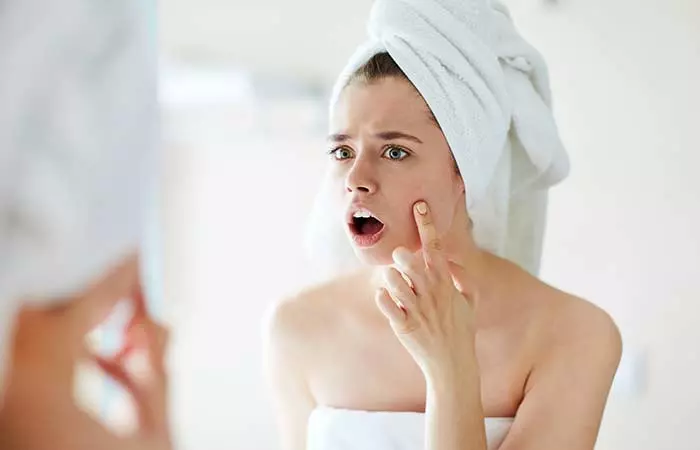
Shea butter is known for its healing properties, which can be attributed to the presence of several fatty acids and plant sterols such as oleic, palmitic, stearic, and linolenic acids. These oil-soluble components do not undergo saponification or convert into soap on coming in contact with alkalis. Shea butter is more non-saponifiable than other nut oils and fats, thus imparting it great healing potential. Raw, unrefined shea butter is effective in curing skin rashes, skin peeling after tanning, scars, stretch marks, frost bites, burns, athletes foot, insect bites and stings, and acne (7).
3. Reduces Skin Inflammation
Shea butter has several derivatives of cinnamic acid that exhibit anti-inflammatory properties.
These properties make it beneficial for the improvement of skin conditions that result from an increase in inflammatory compounds (8). Generalized inflammations from conditions like dermatitis and rosacea can be alleviated by using shea butter on the affected area. Sunburns, rashes, cuts, and scrapes that can result in swelling can also be treated using this butter.
4. Anti-Aging And Anti-Free Radical Agent
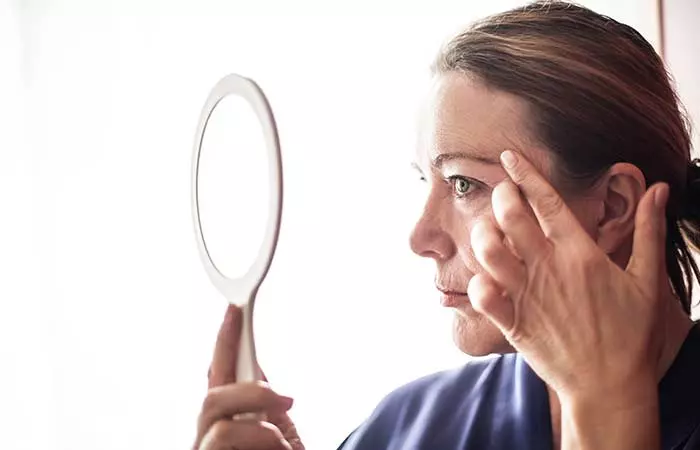
Shea butter is considered as one of the best anti-aging agents for the skin. It stimulates the production of collagen, the youthful scaffolding protein in the skin. The vitamins A and E found in this butter keep the skin supple, nourished, and radiant. If used regularly, it reduces wrinkles and also prevents premature wrinkles and facial lines. Its anti-aging properties can also be attributed to its ability to increase circulation to the skin and promote cell renewal.
These vitamins, along with catechins, also exert an antioxidant effect against free radicals that damage the skin. These free radicals are often found in our environment in pollutants and irritants. The sun’s rays can also increase the free radicals in our skin, which can easily damage the skin cells. The cinnamic acid esters in the shea fat prevent damage from these compounds by giving your skin an antioxidant boost (9, 10).
5. Provides Relief To Itchy And Peeling Skin
For itching skin, both the moisturizing and the anti-inflammatory properties of shea butter prove to be beneficial. Dryness can cause your skin to start peeling and/or become flaky. It can cause the skin to itch. The moisturizing fatty acids of shea butter can provide relief by supplying the skin with the oils it needs. If the itching is due to a skin condition like psoriasisi A chronic autoimmune skin condition that forms scales, itchy patches and causes skin inflammation. , the anti-inflammatory activity of shea butter works really well to alleviate it (11, 12).
6. Restores The Elasticity Of The Skin
The non-saponifiable matter and vitamin F in this butter are vital ingredients for maintaining the skin’s elasticity. Shea butter also improves the production of collagen in the skin. Thus, its application restores the natural elasticity of the skin besides hydrating, softening, and beautifying it (13). Restored elasticity also ensures reduced wrinkles and blemishes.
7. Reduce Razor Irritation And Bumps
Shaving hair using razors can often leave your skin irritated and itchy. At times, it might even develop bumps post shaving as a result of the irritation. Shea butter can help reduce this as it moisturizes and soothes the irritated skin. You can also apply the butter a day prior to shaving to smoothen the skin and hair. This will make the shaving process easier and faster and doesn’t leave any irritated spots behind (14, 15).
8. Reduces Stretch Marks
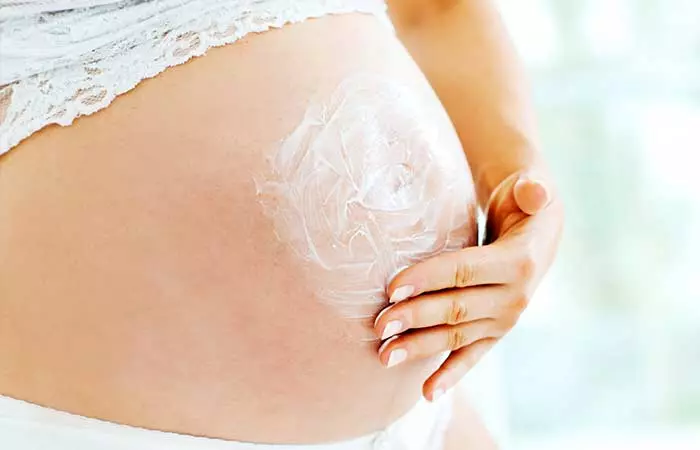
Shea butter is often used as a base in ointments or creams prepared commercially for stretch mark treatment. This is because it can dramatically help prevent and reduce stretch marks formed during pregnancy due to weight gain and/or weight loss. These marks are formed when the skin stretches beyond its elastic capacity. The application of shea butter will restore the natural elasticity of the skin and also improve collagen production. It is a natural emollient. Daily massage of the affected area with this skin healing butter can lighten stretch marks (16).
9. Helps Soothe Skin And Baby Diaper Rash
Unrefined shea butter is an excellent natural moisturizer that is devoid of chemicals. Thus, it is ideal for baby care as besides being gentle and soft on the skin, it is specially adapted for the delicate and sensitive skin of babies. It can be applied after a bath and also used for healing eczema or diaper rash on the skin of babies and toddlers (7).
10. Excellent Lip Care
Shea butter is easily absorbable and provides extra moisture and nutrients that the lips need during the cold season and dry weather conditions. Thus, it acts as a perfect lip balm and is also effective for treating dry and chapped lips. When applied, it forms a barrier on the lips and retains moisture in the skin (14).
After this extensive list of how shea butter can benefit our skin, let us now discuss its benefits for the hair. It is considered as a natural conditioner for the hair, thanks to its moisturizing and healing properties.
Benefits Of Shea Butter For Hair
Let’s also delve deeper into some of the benefits of this miracle butter for your hair care. Some of the numerous shea butter benefits for hair are given below.
11. Repairs Damaged Hair

A number of chemical treatments like straighteners, perms, and curlers are responsible for stripping off the natural moisture from the hair. Shea butter can help restore this lost moisture. It also protects the hair from harsh weather conditions and the harmful free radicals in the air and water. Moreover, shea butter has a low SPF that is sufficient to protect the hair from sun damage caused due to exposure to ultraviolet radiation. It repairs the damage that has already been caused by the harsh weather and the sun. This is largely due to the fact that once absorbed, shea butter coats the hair shaft so that it is protected from a heat tool or any other damaging material being passed along the hair. This is particularly beneficial for processed or colored hair. Its moisturizing and emollient properties may also help protect the hair against damage caused by environmental factors (17).
Here is a simple way to include shea butter in your hair care regimen:
- Take a tablespoon of raw or unrefined shea butter and melt it in the microwave for 30-60 seconds.
- Once the butter cools down slightly, add a few drops of lavender essential oil. This step is not compulsory.
- Make small sections of your hair and apply the liquefied butter to the scalp and entire hair length.
- Leave it on for half an hour and then rinse your hair with a mild shampoo.
12. Prevents Hair Loss
The fatty acids of shea butter condition the scalp and hair. It also provides many essential nutrients that improve both scalp and hair health. These, in turn, will make your hair follicles stronger and reduce hair fall and hair loss. Another important property of shea butter that can prevent hair loss is its anti-inflammatory properties. Scalp conditions can be treated by these compounds, thus reducing hair loss. Your hair will grow thicker and have a glowing natural look when you use shea butter (18).
13. Soothes Dry And Itchy Scalp
Shea butter is effective in soothing a dry, itchy scalp or dandruff. It possesses anti-inflammatory qualities and rich fat that get absorbed into the skin without leaving a greasy residue behind or clogging the pores (19). Hence, it is extremely effective in providing relief from a dry scalp, scalp psoriasis, and other scalp conditions.
14. Treats Split Ends And Breakage
Shea butter exerts moisturizing and regenerative effects on the hair and scalp. This strengthens the hair strands and reduces breakage. Also, being rich in vitamins A and E, it soothes dry hair and mends split ends (18, 20).
15. Effective Natural Conditioner
The presence of vitamins A and E makes shea butter an excellent choice to moisturize your hair from the roots to the tips. It can be used as a natural conditioner. It is highly effective in locking in moisture, without leaving the hair greasy or heavy (19). Dr. Anna Chacon, MD, FAAD, a double board-certified dermatologist, says, “Due to its smoothening qualities, shea butter is an excellent approach to prevent frizz. Shea butter-infused haircare products can help moisturize your hair and calm your scalp, which can reduce frizz.”
16. Keep Rebel Curls In Place
Shea butter for hair is great for softening and revitalizing brittle strands. Due to its non-greasy nature, it helps to control and spread the excess oil in the scalp. Massaging the hair with generous amounts of shea butter can give you soft, silky, and luscious tresses. This benefit of shea butter is applicable for dry as well as fragile, curly hair. Shea butter should be applied twice a week for hair growth. This will improve the hair texture and moisturize the hair. It has wide usage in curly hair treatments due to its emollient qualities (24).
17. Enhances Hair Shine
Anecdotal evidence suggests that shea butter’s rich fatty acids improve hair texture, giving it a healthier, more shiny appearance. It promotes a natural gloss and can help hair maintain moisture with regular application, leaving it soft and lustrous.
So, this was all about the hair and skin benefits of shea butter. However, this rich butter also possesses some more benefits that make it more versatile. Read on to know more about these.
More Shea Butter Benefits For Health
Except as a superior moisturizer, shea butter is used to treat various health issues too. Check out here, what are they.
18. Soothes Muscle Aches
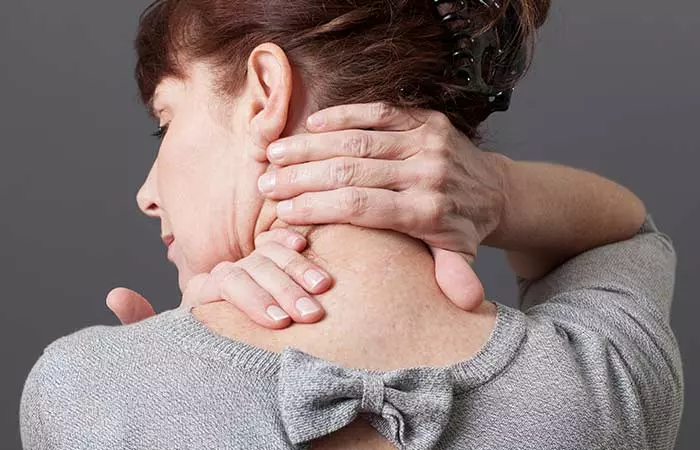
Muscular pain often results from an inflammation at the affected site due to exertion or a muscular ailment. Traditionally, shea butter has been extensively used in Africa to relieve muscle aches and soreness. Even though there is no concrete proof for this, feedback from people who have used shea butter to massage the affected site showed that they noticed a reduction in the swelling as well as the pain (21).
19. Rheumatism
Rheumatism is often characterized by joint pain, inflammation, and stiffness. The pain and swelling can also be present just in the muscles or the fibrous tissue. It is used as an ointment on the parts of the body affected by rheumatism to relieve the swelling and pain. Its anti-inflammatory properties are of key importance here as rheumatism is basically an inflammatory disease (22).
20. Arthritis
A chronic joint disorder that is often associated with increasing age, obesity, and trauma, arthritis can be very painful for people who suffer from it. The pain is almost constant and disrupts basic movement and the quality of life in an arthritis patient. The unsaponifiable material of shea butter is primarily composed of triterpenes. These compounds have anti-inflammatory and antioxidant properties. Its usage by arthritis patients has shown excellent results in alleviating the swelling and pain. The exact mechanism of action is still unknown. However, the triterpenes are considered the main contributing factor for these results (22, 21).
21. Nasal Inflammation And Nasal Congestion
The next time you experience nasal congestion, all you need to do is apply some shea butter in your nostrils using your finger. This might sound weird, but it works. Nasal congestion is often a result of inflammation of the inner linings of the nasal passages. The anti-inflammatory compounds of shea butter can reduce this inflammation and clear your nostrils. In a study conducted to test the efficacy of shea butter, the participants experienced nasal congestion clearance in just 90 seconds (23).
22. Lowers Cholesterol
As we mentioned earlier, shea butter is edible and is used by many people in Africa for food preparation. An unknown advantage of adding shea butter to your diet is its ability to lower cholesterol in the blood. This butter is rich in stearic acid, a type of saturated fatty acid that was shown to reduce lipoprotein and plasma cholesterol levels in a study published in the American Journal of Clinical Nutrition (24).
23. Helps Treat Diarrhea
Diarrhea is a symptom of many ailments and can also occur just by itself. It can be treated using a wide range of medicines and herbal concoctions. There is increased demand these days for the addition of shea butter to dietary-aid products that are being formulated for diarrhea treatment. This is based on the traditional usage of shea butter for its anti-diarrheal properties (25).
A few other uses of shea butter are discussed in the next section.
Shea Butter Uses
Shea Butter has innumerable uses! Find out how this butter is used in a variety of ways.
24. Wound Healing
Shea butter has skin moisturizing properties, and these are accompanied by healing properties because of the wide variety of phytonutrientsi Natural chemicals produced by plants with antioxidant and anti-inflammatory properties that help support overall health. it contains. Wounds, cuts, and abrasions are healed quickly with regular application of shea butter. It gets easily absorbed into the deeper layers of the skin, where it supplies all the essential fats and nutrients while enhancing the cell repair function by increasing microcirculation (26).
25. Insect Bites
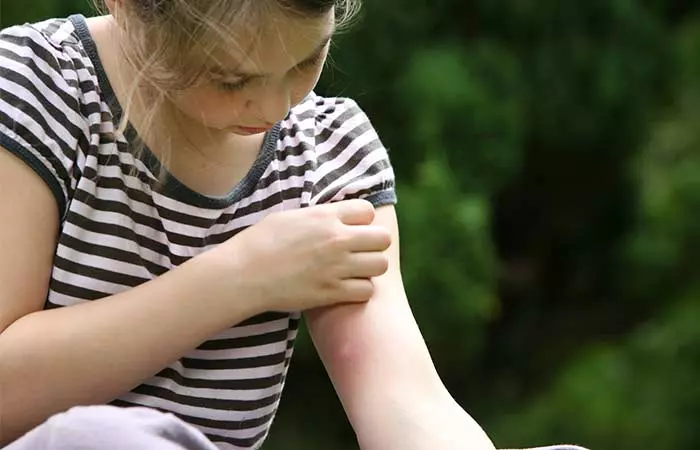
Due to its high content of vitamin A, it promotes healing and disinfection and soothes skin allergies like poison ivy and insect bites (26). The anti-inflammatory and antimicrobial properties accelerate the healing process (7). Insect bites are often prone to developing an infection, and this can be prevented by using shea butter on it.
26. Dermatitis, Psoriasis, And Eczema
Conditions like dermatitis, psoriasis, and eczema cause the skin to become dry, flaky, patchy, scaly, and/or itchy. And to treat them, we need an ingredient that works as a deep moisturizer and alleviates the inflammation. Shea butter suits this profile perfectly. It is considered as an excellent moisturizer for eczema, psoriasis, and dermatitis because of its efficacious emollient and humectanti A common moisturizing substance found in lotions and shampoos attracts water from the air and helps hydrate the skin. properties. The anti-inflammatory properties of this thick butter can be employed for lessening the swelling and itching (11, 12). Doctors often recommend shea butter to people suffering from these skin ailments as it is safe and well tolerated.
27. UV Protection
Shea butter acts as a natural sunscreen by providing protection against the ultraviolet radiations of the sun, though the level of protection offered may be variable. Cinnamic acid, found in shea butter, is a compound that provides UV protection, and the SPF ranges from 6-10 depending on the butter’s quality. It is not recommended to use shea butter alone as a sunscreen as its SPF is considered to be low to provide ample protection from the harmful rays. Shea butter is best used after sun exposure to soothe the skin and also reverse the oxidative damage caused by the sun (27).
28. An Alternative To Coconut Oil, Butter, Or Olive Oil In Cooking
Healthy fats, antioxidants, and anti-inflammatory compounds – all of these make shea butter a viable and better option than regular butter or even coconut oil and olive oil. It might take a day or two to get used to its taste, but its benefits are plenty and worth the adjustment. Use it for stir-frying or simply add a small dollop to your morning smoothie to reap its benefits. You could even substitute it for butter or lard for your toasts, sandwiches, and pancakes. As always, opt for the unrefined version, even for cooking/eating purposes.
Fafa Gilbert, a blogger, discusses how she uses shea butter to improve her skin health. She writes that shea butter can be widely used as a natural moisturizer and hair cream. She adds, “The nature of my job means my hands are in water constantly, which in turn rids my skin of its natural oils. After each cooking session, I scoop a thumb sized amount of my Shea body butter with a teaspoon of fine sea salt into my palm. I rub my palm together and scrub the back of each hand with the opposite hand for about 2 minutes. I rinse it off with warm water and wipe my hands with a clean towel (i).”
So many benefits! But you might still be a little confused about how to find the best shea butter. Well, your doubts will be cleared in the next section. We’ll also talk about the best way to store it.
Selection And Storage Tips
Shea Butter Buying Tips
Keep these pointers in mind when buying shea butter:
- Look for the raw or unrefined version of shea butter.
- Ensure that the butter has come from a reliable source or company that believes in ethics, fair trade, and is environment-friendly.
- Check the shea butter’s smell. It should be a little nutty or earthy. Any plastic-like or chemical scent indicates that it is not an unrefined version.
- If possible, try on a small amount of shea butter on your arm. It should be soothing and moisturizing.
- As far as the color is concerned, it ranges quite a bit when it comes to the unrefined version. Make sure the butter you are planning to purchase is not ivory-colored as a lighter color indicates that it has gone through the refinement process of bleaching.
How To Store Shea Butter
The best way to store 100% shea butter is to store it in a cool environment in an airtight container. Keep it away from the sun. Quite often, vitamin E is added to shea butter to increase its shelf life. On an average, 100% shea butter has a shelf life of two years. According to Dr. Chacon, “Unrefined shea butter typically lasts for two years and a little over 24 months after it was made and packaged. An approximate shelf life that is impacted by temperature and storage.” If you sense an acidic/rancid smell, it might be time to throw it away.
Using shea butter for skin is a common practice as it helps to keep the skin moisturized and healthy. It can be incorporated into various recipes. Keep reading to check out easy recipes that you can concoct at home with shea butter.
Shea Butter Recipes
1. Body Butter Lotion
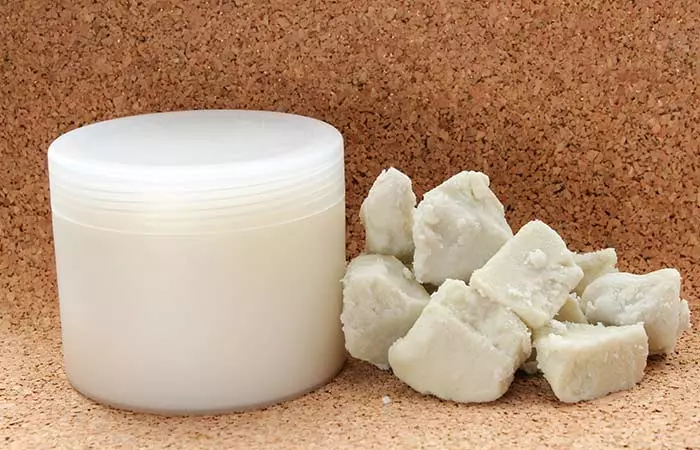
You Will Need
- 1 cup raw shea butter
- 1/2 cup virgin coconut oil
- 1/2 cup almond oil
Recipe
- Melt the coconut oil and shea butter in a double boiler.
- Mix well and let it cool down for a couple of minutes.
- Add almond oil and mix well.
- Place this in the refrigerator for 10-15 minutes. The oils should start to solidify a little.
- Once the natural solidification process has started, whip the oil blend using a hand mixer or a kitchen aid mixer until you get a thick, creamy consistency.
- Transfer this to an airtight container and keep it aside. Allow it to set.
- Use as and when required to moisturize the body.
You can also add essential oils of your choice in the almond oil step.
 Quick Tip
Quick Tip2. Lavender Mint Lip Balm

You Will Need
- 2 tablespoons raw shea butter
- 1 tablespoon beeswax
- 1 tablespoon virgin coconut oil
- 6-7 drops lavender oil
- 6-7 drops peppermint oil
Recipe
- Melt the shea butter, beeswax, and coconut oil in a double boiler.
- Let them cool down slightly and then add the essential oils.
- Mix thoroughly and pour the concoction into small jars or lip balm tins.
- Leave aside until the contents set.
- Use once or twice a day as a regular lip balm.
If you are wondering where you can get your hands on good-quality shea butter, scroll down to the next section.
Where To Buy Shea Butter?
With the progress in e-commerce websites, most brands for raw and organic shea butter are available for purchase online. Some organic stores and large departmental stores may also stock them in their body care and hair care sections.
While it is important to know how a particular ingredient can benefit you, it is equally important to know its side effects. For shea butter, these are listed below.
Side Effects Of Shea Butter
These side effects can result from topical application or ingestion of shea butter:
- Itchy rashes
- Hives
- Nausea
- Weakness
- Dizziness
- Headache
- Abdominal pain
While using shea and cocoa butter for skin is popular, especially among people who have dry skin, an oft-asked question is how the two are different. The following section offers a comparison.
Shea Butter Vs. Cocoa Butter
| Aspect | Shea Butter | Cocoa Butter |
| Source | Derived from shea tree nuts | Extracted from cocoa beans |
| Color And Scent | Off-white or ivory with a mild, nutty scent | Creamy, pale yellow with a rich, chocolatey scent |
| Skin Benefits | Helps repair damaged skin | Offers intense moisturization |
| Nutrient Content | Rich in vitamins A, E, and F, along with anti-inflammatory and antioxidant properties | Rich in fatty acids and antioxidants that help repair skin and offer rejuvenation (28) |
| Suitable Skin Types | Suitable for all skin types, including sensitive skin | Ideal for dry or mature skin types |
Infographic: Benefits Of Shea Butter For Skin
Shea butter is a well-known cosmetic ingredient for skin softening. The emollient and anti-inflammatory properties of this creamy consistency butter offer many skin benefits. While it offers many skin benefits, there are a few very important benefits of shea butter you must be aware of. Check out the infographic below to learn about the top benefits of shea butter for the skin. Illustration: StyleCraze Design Team
Shea butter, derived from the nuts of the Shea tree, is known for its moisturizing and healing properties. Its antimicrobial and anti-inflammatory properties help treat many skin issues and irritations effectively. Originally from Africa, shea butter is now used widely in many cosmetic and medicinal formulations all around the world. It is not only rich in vitamin A and vitamin E but also provides mild sun protection as well. While unrefined shea butter benefits your skin with its all-natural goodness of fatty acids and vitamins, it is often refined to be incorporated into various formulations. Along with its benefits for your skin and hair health, shea butter is also known to help soothe muscle aches, treat diarrhea, and relieve nasal congestion. While it is usually safe to use, it may lead to itchiness and rashes for some.
Frequently Asked Questions
Why is shea butter called ‘women’s gold’?
In Africa, many women earn their livelihood by working in the shea butter industry, giving it the name ‘women’s gold’.
Is shea butter edible?
Yes, it is safe to eat.
What is shea butter’s shelf life?
The average shelf life of shea butter is two years, but it can fluctuate depending on the brand.
Is shea butter natural?
Yes, shea butter is extracted from the nuts of the shea tree, which grows naturally in West Africa.
What kind of shea butter is best?
Always look for raw/unrefined and organic, the unrefined, raw version is considered the best for usage. This is because its nutritional qualities are still intact. Opt for a grade A version if possible.
What does shea butter smell like?
Unrefined shea butter has an earthy or nutty smell. It can have a little smokey smell as well.
Are all shea butters the same?
No, they are not! Shea butter is available in different varieties, depending on the processing undergone. The unrefined and refined versions are the most popular.
Is shea butter vegan-friendly?
If you are purchasing 100% shea butter, it is vegan-friendly as it is a pure plant-based product. Products that contain shea butter may not be vegan-friendly due to the additional ingredients present.
Is shea butter safe for people with nut allergies?
Even though shea butter comes from a tree nut, no nut allergies have been reported to it so far.
Does shea butter remove dark spots?
Possibly. According to anecdotal evidence, shea butter may help reduce dark spots, blemishes, and hyperpigmentation. It may also help even out your skin tone.
Illustration: Best Shea Butter Benefits For Skin, Hair And Health
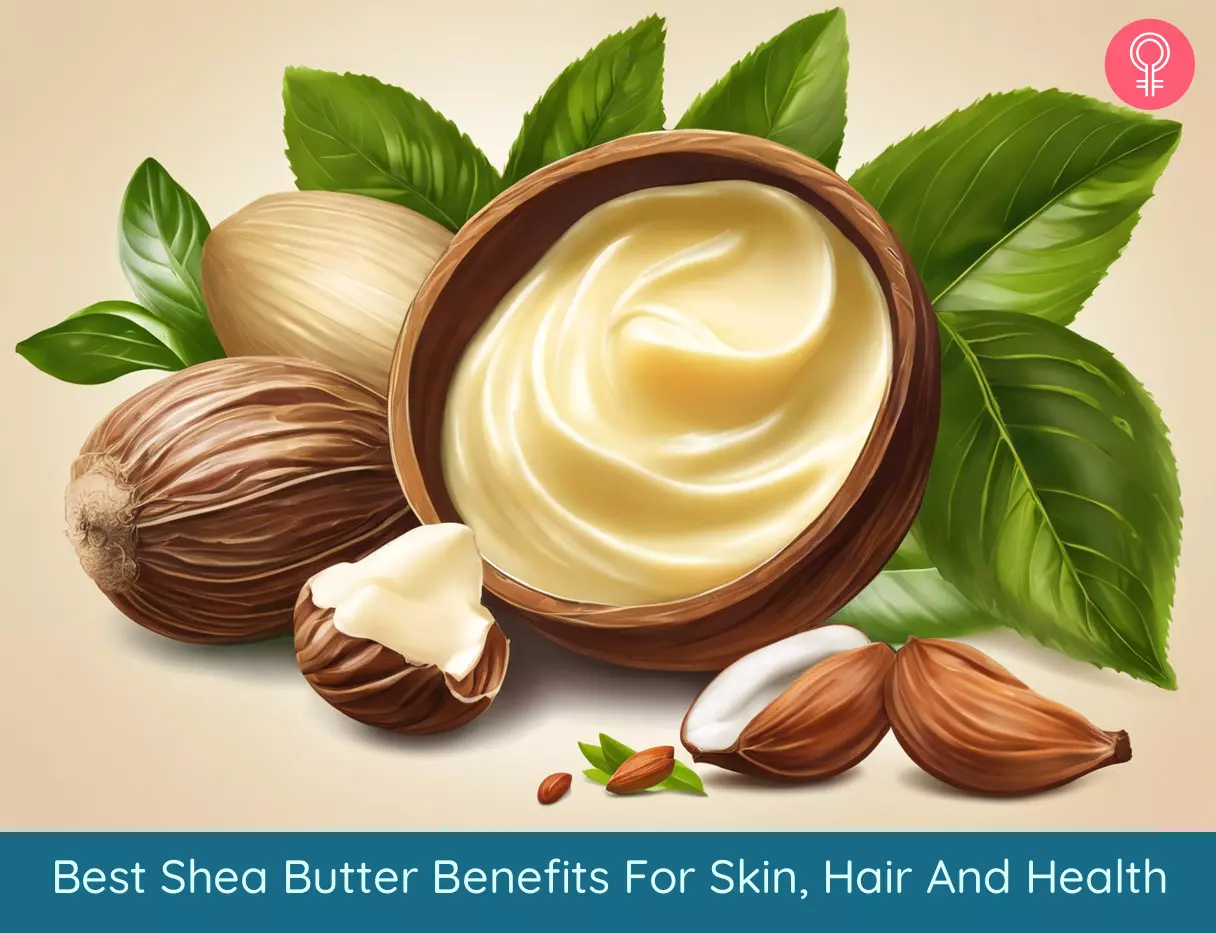
Image: Stable Diffusion/StyleCraze Design Team
Experience the wonders of shea butter for your face! Play this enlightening video now to uncover the amazing benefits and versatile uses of shea butter in your skincare routine.
Personal Experience: Source
StyleCraze's articles are interwoven with authentic personal narratives that provide depth and resonance to our content. Below are the sources of the personal accounts referenced in this article.
i. Homemade Shea Body Butter & Scrub
https://ndudu-by-fafa.blogspot.com/2016/08/homemade-shea-body-butter-scrub.html?m=1
References
Articles on StyleCraze are backed by verified information from peer-reviewed and academic research papers, reputed organizations, research institutions, and medical associations to ensure accuracy and relevance. Read our editorial policy to learn more.
- Optimization of solvent extraction of shea butter (Vitellaria paradoxa) using response surface methodology and its characterization
https://www.ncbi.nlm.nih.gov/pmc/articles/PMC4711458/ - The role of vitamin E in normal and damaged skin
https://pubmed.ncbi.nlm.nih.gov/7633944/ - Physico-chemical characteristics of shea butter oil from the shea districts of Uganda
https://www.bioline.org.br/pdf?nd10010 - Influence of climate on the tocopherol content of shea butter
https://pubmed.ncbi.nlm.nih.gov/15137838/ - Bioactive Compounds for Skin Health: A Review
https://www.ncbi.nlm.nih.gov/pmc/articles/PMC7827176/ - Medical Benefits of the Shea Nut Tree
https://digitalscholarship.tnstate.edu/cgi/viewcontent.cgi?referer=&httpsredir=1&article=1000&context=biology_students - Anti-Inflammatory and Skin Barrier Repair Effects of Topical Application of Some Plant Oils
https://www.ncbi.nlm.nih.gov/pmc/articles/PMC5796020/ - Anti-inflammatory and chemopreventive effects of triterpene cinnamates and acetates from shea fat
https://pubmed.ncbi.nlm.nih.gov/20484832/ - Phenolic constituents of shea (Vitellaria paradoxa) kernels
https://pubmed.ncbi.nlm.nih.gov/14518954/ - Antioxidant and antimicrobial activities of cinnamic acid derivatives
https://pubmed.ncbi.nlm.nih.gov/22512578/ - The Efficacy and Tolerability of Turmeric and Salicylic Acid in Psoriasis Treatment
https://pubmed.ncbi.nlm.nih.gov/35516971/ - Repair and Maintenance of the Epidermal Barrier in Patients Diagnosed with Atopic Dermatitis
https://www.ncbi.nlm.nih.gov/pmc/articles/PMC3140899/ - Trends in the Use of Botanicals in Anti-Aging Cosmetics
https://www.ncbi.nlm.nih.gov/pmc/articles/PMC8230945/ - Skin acceptability of a cosmetic moisturizer formulation in female subjects with sensitive skin
https://www.ncbi.nlm.nih.gov/pmc/articles/PMC5933397/ - Experimental study comparing burn healing effects of raw South African Shea butter and the samples from a Libyan market
https://pubmed.ncbi.nlm.nih.gov/33614438/ - A Narrative Review of Current Striae Treatments
https://www.ncbi.nlm.nih.gov/pmc/articles/PMC9777947/ - Comparative sunscreen and stability studies of shea butter from Nigeria
https://www.researchgate.net/publication/369179033_Comparative_sunscreen_and_stability_studies_of_shea_butter_from_Nigeria - Effects of Topical and Dietary Use of Shea Butter on Animals
https://www.researchgate.net/publication/277021242_Effects_of_Topical_and_Dietary_Use_of_Shea_Butter_on_Animals - Role and Mechanisms of Phytochemicals in Hair Growth and Health
https://www.ncbi.nlm.nih.gov/pmc/articles/PMC9963650/ - The Role of Moisturizers in Addressing Various Kinds of Dermatitis: A Review
https://www.ncbi.nlm.nih.gov/pmc/articles/PMC5849435/ - Effects of Tocotrienol Supplementation on Hair Growth in Human Volunteers
https://www.ncbi.nlm.nih.gov/pmc/articles/PMC3819075/ - Validating Efficacy of Shea Nut Oil Extract in Knee Osteoarthritis Patients
https://www.ncbi.nlm.nih.gov/pmc/articles/PMC3872419/ - Shea Nut Oil Triterpene Concentrate Attenuates Knee Osteoarthritis Development in Rats: Evidence from Knee Joint Histology
https://www.ncbi.nlm.nih.gov/pmc/articles/PMC5008785/ - Preliminary studies on nasal decongestant activity from the seed of the shea butter tree Butyrospermum parkii.
https://www.ncbi.nlm.nih.gov/pmc/articles/PMC1429586/?page=1 - Fat high in stearic acid favorably affects blood lipids and factor VII coagulant activity in comparison with fats high in palmitic acid or high in myristic and lauric acids
https://pubmed.ncbi.nlm.nih.gov/8310987/ - The Shea Butter Industry Expanding in West Africa
https://www.researchgate.net/publication/272023024_The_Shea_Butter_Industry_Expanding_in_West_Africa - A review of ethnomedicinal uses of shea butter for dermatoses in Sub-Saharan Africa
https://pubmed.ncbi.nlm.nih.gov/33480103/ - Butyrospermum parkii butter increased the photostability and in vivo SPF of a molded sunscreen system
https://pubmed.ncbi.nlm.nih.gov/32385930/# - Cocoa bioactive compounds: significance and potential for the maintenance of skin health
https://pubmed.ncbi.nlm.nih.gov/25116848/
Read full bio of Dr. Sravya Tipirneni
- Dr. Anna Chacon, MD, FAAD, is a double board-certified dermatologist with over 7 years of experience. She has authored many peer-reviewed articles and managed clinical research studies during her fellowship. She completed her medical school in the PLME (Program of Liberal Medical Education) at Brown University.
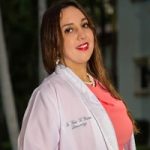 Dr. Anna Chacon, MD, FAAD, is a double board-certified dermatologist with over 7 years of experience. She has authored many peer-reviewed articles and managed clinical research studies during her fellowship. She completed her medical school in the PLME (Program of Liberal Medical Education) at Brown University.
Dr. Anna Chacon, MD, FAAD, is a double board-certified dermatologist with over 7 years of experience. She has authored many peer-reviewed articles and managed clinical research studies during her fellowship. She completed her medical school in the PLME (Program of Liberal Medical Education) at Brown University.
Read full bio of Kushneet Kukreja
Read full bio of Ravi Teja Tadimalla
Read full bio of Aparna Mallampalli








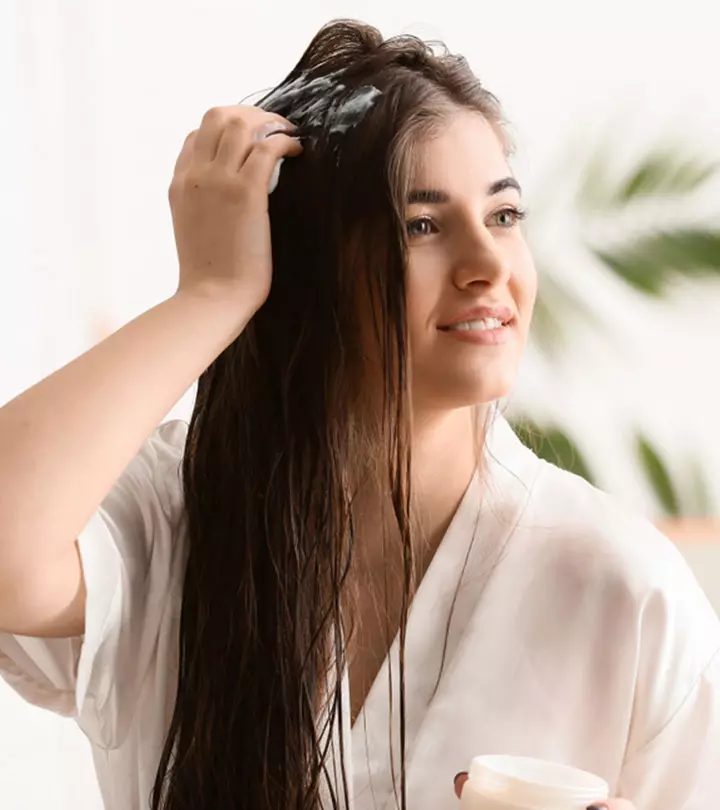
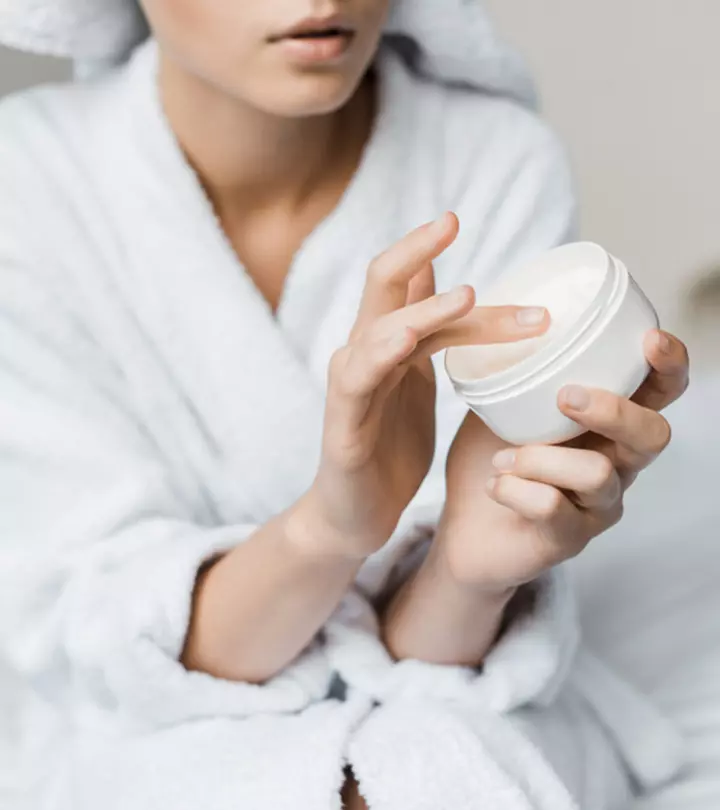
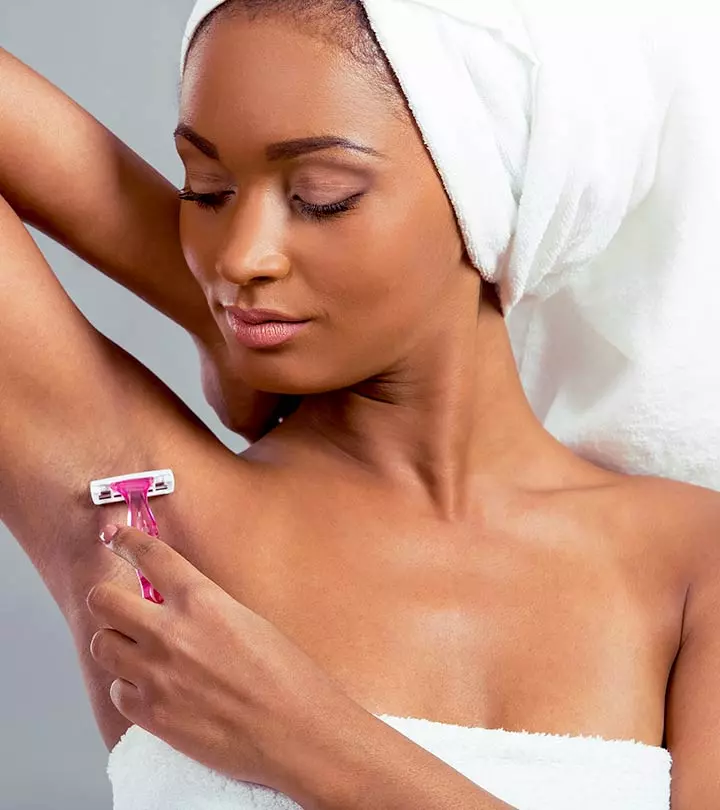
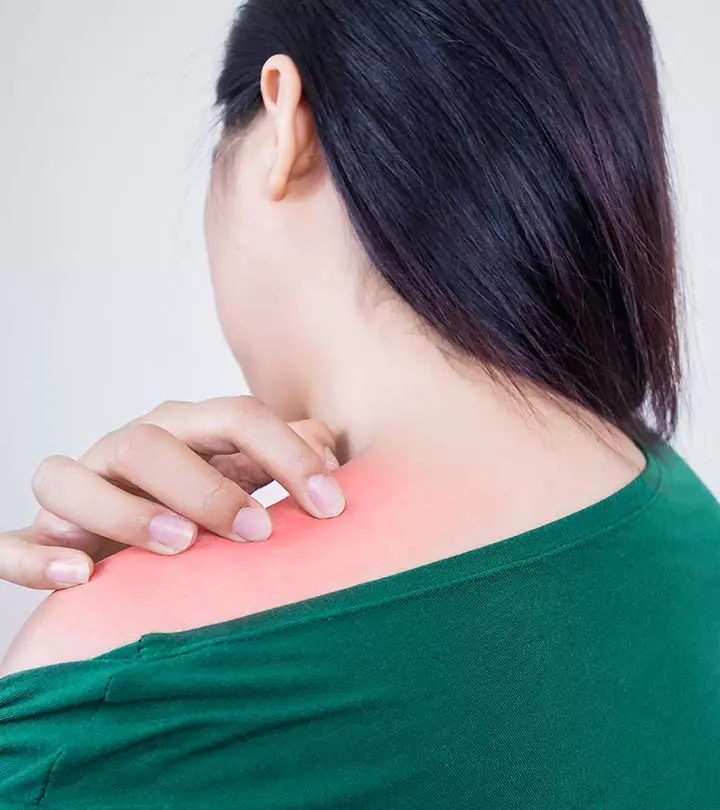
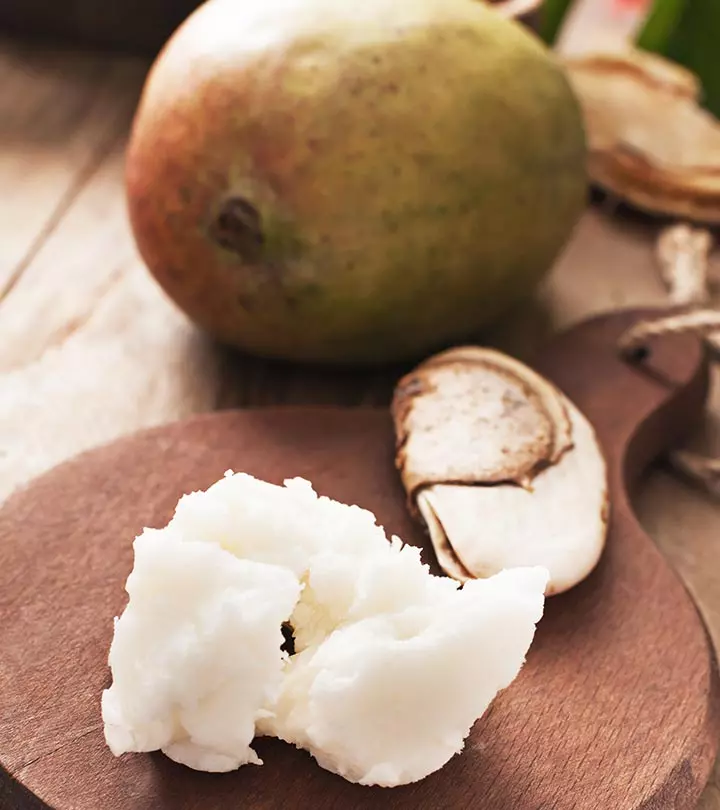
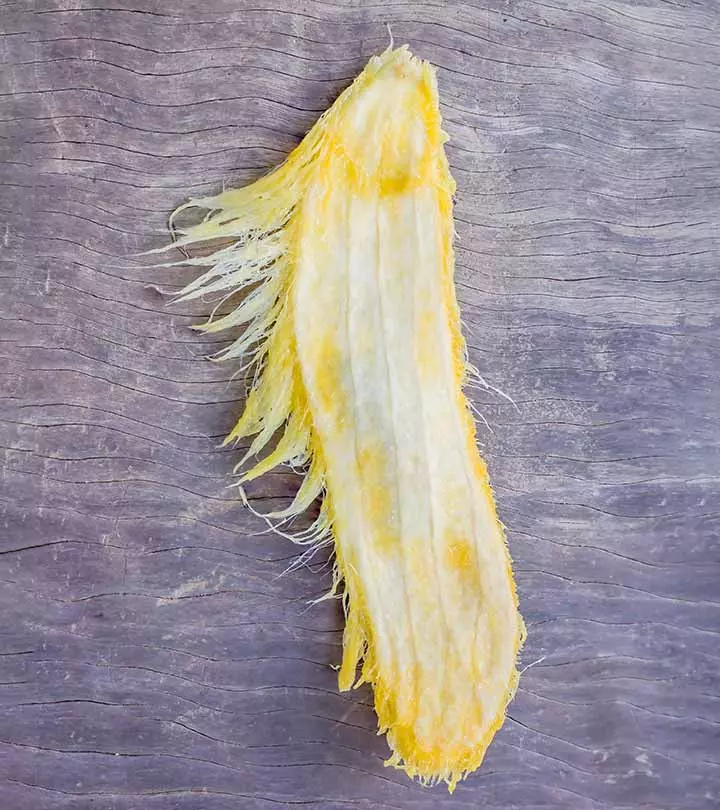
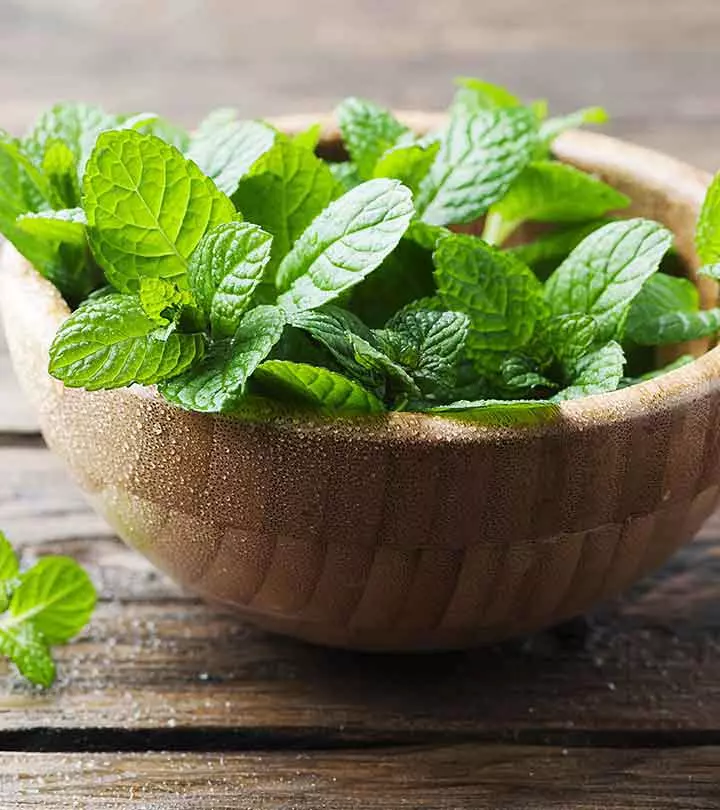
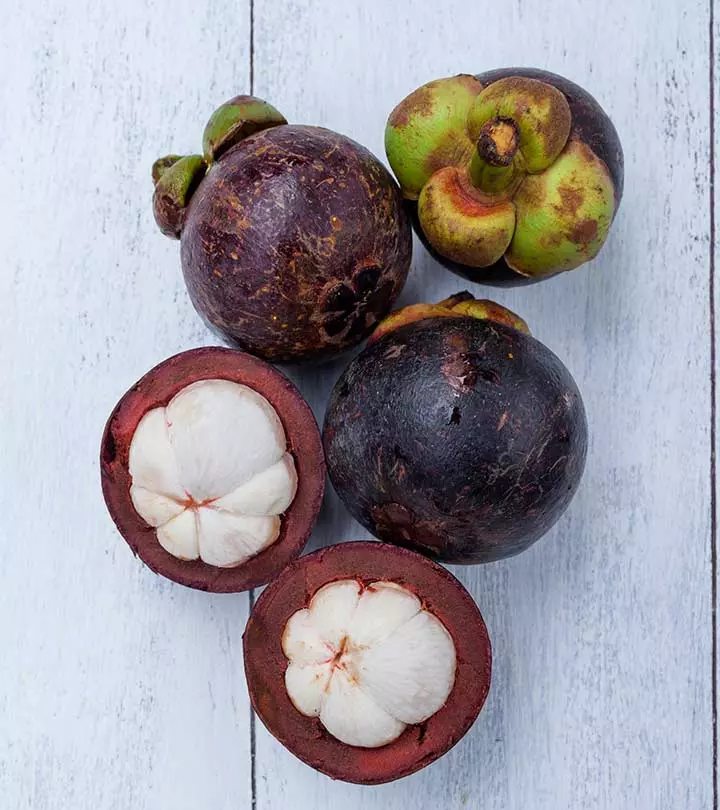
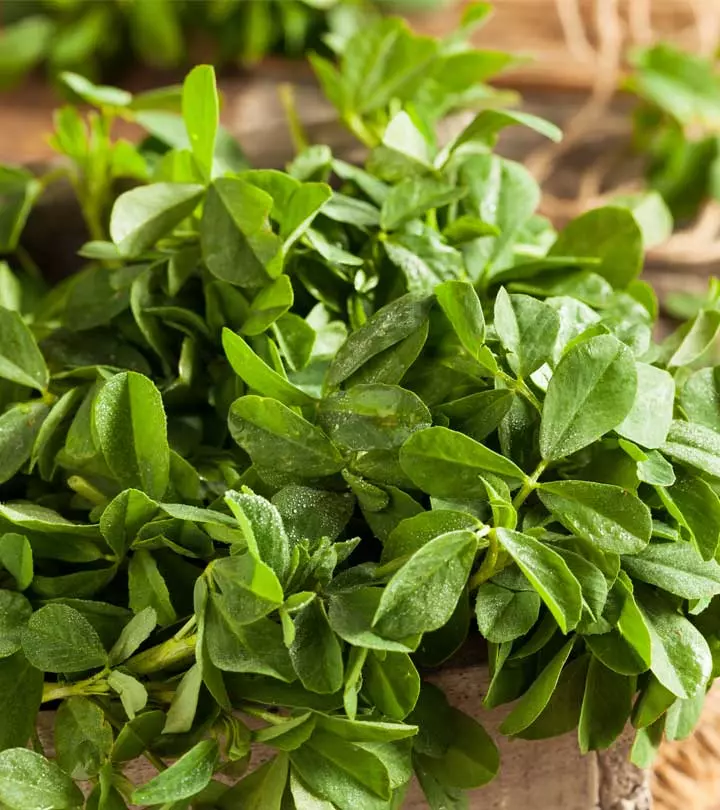
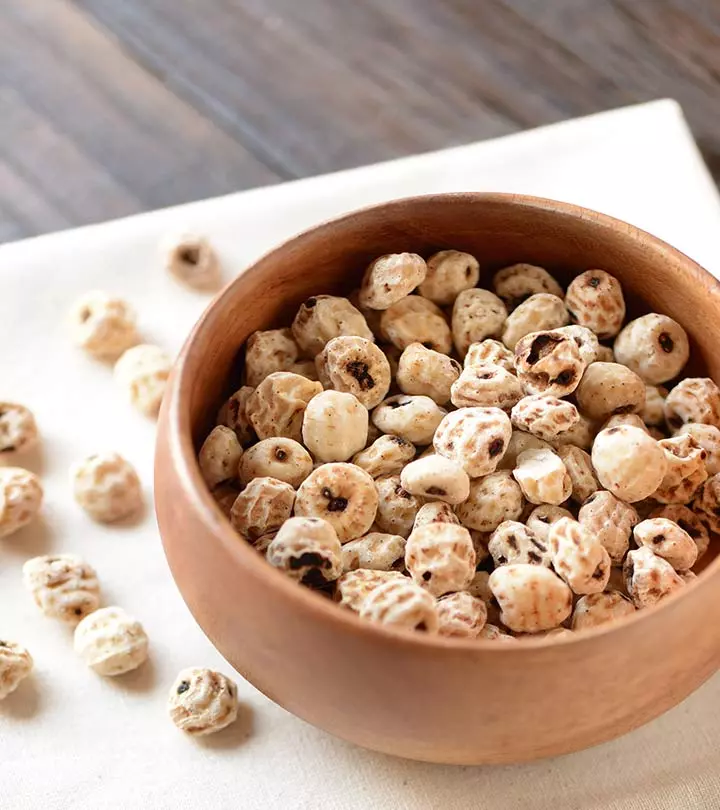
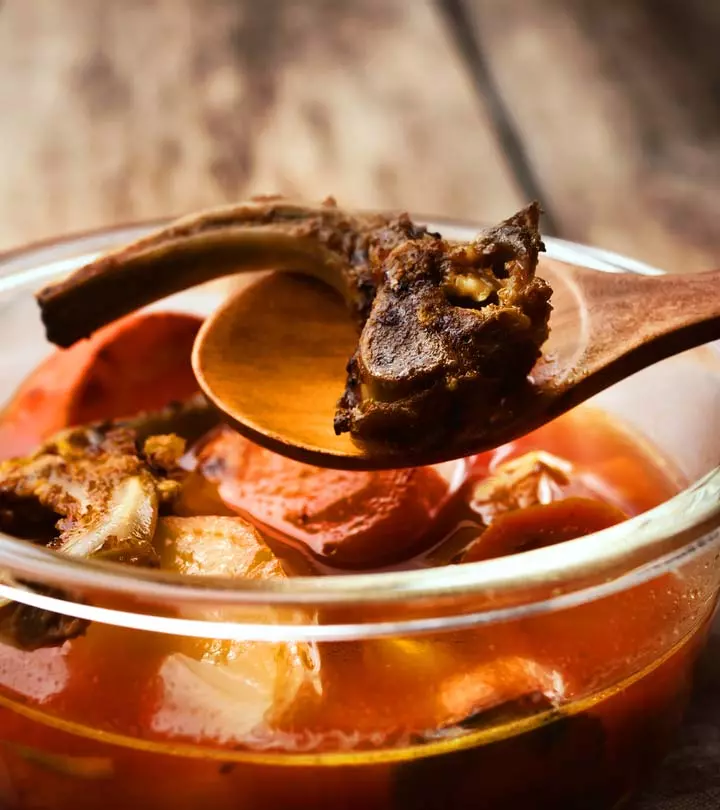
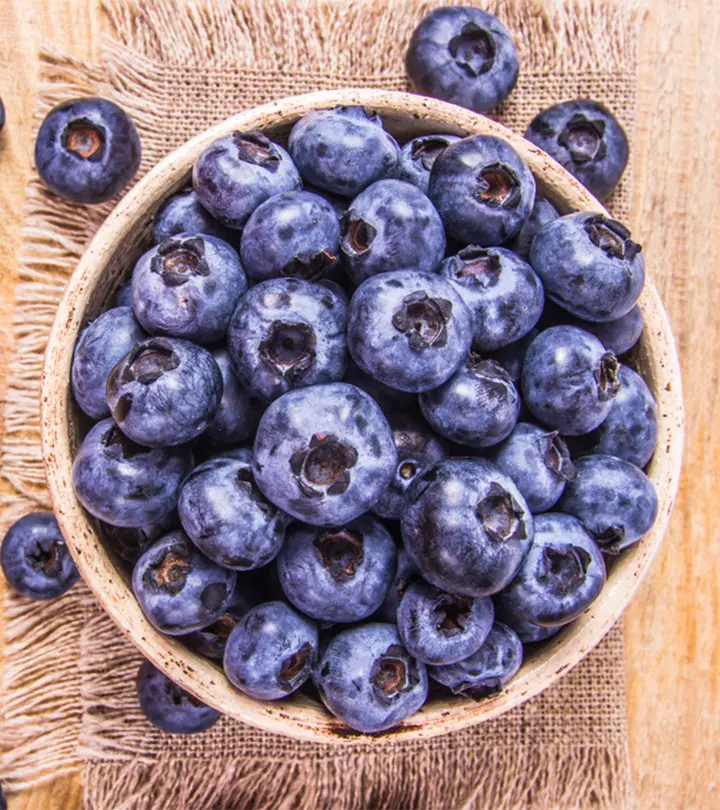
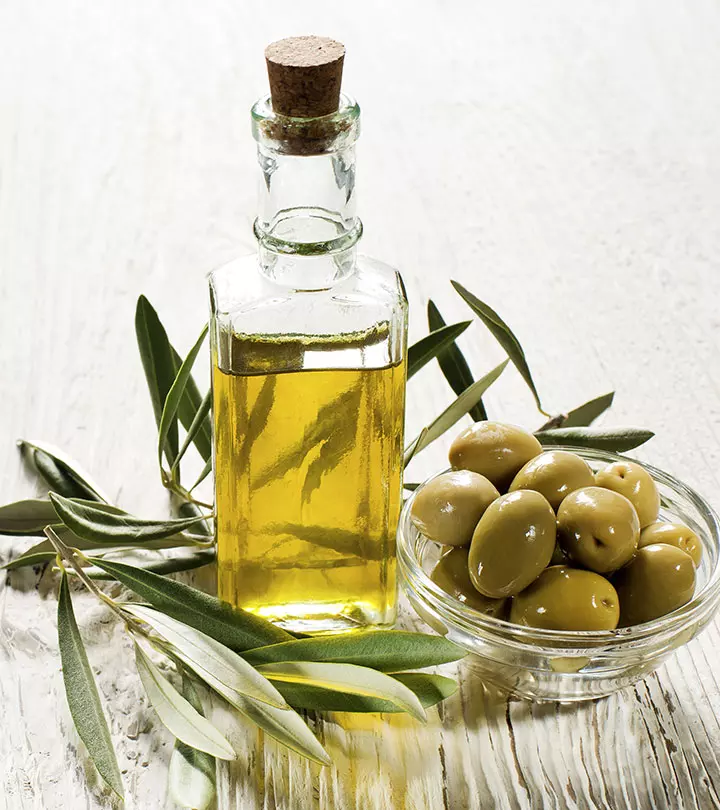
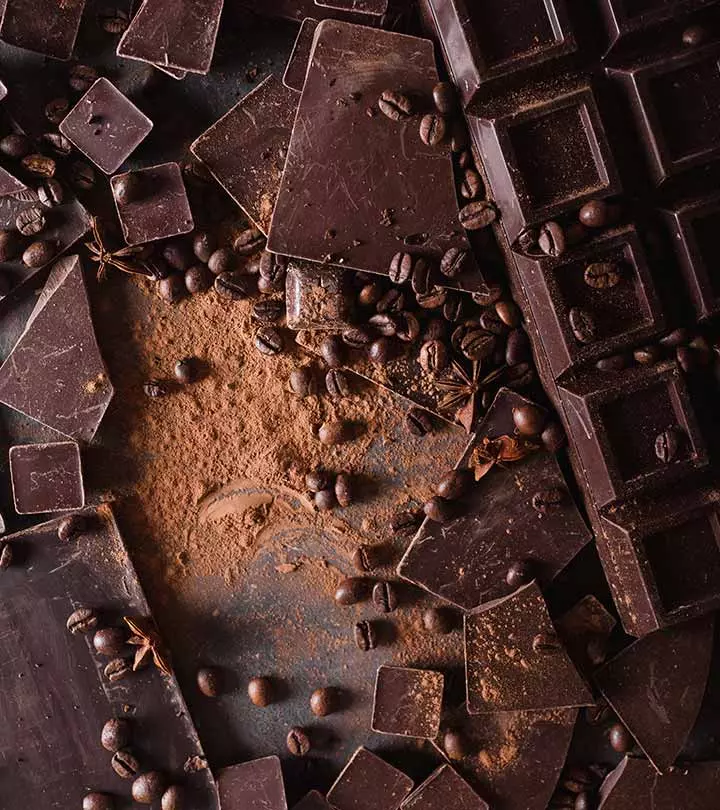
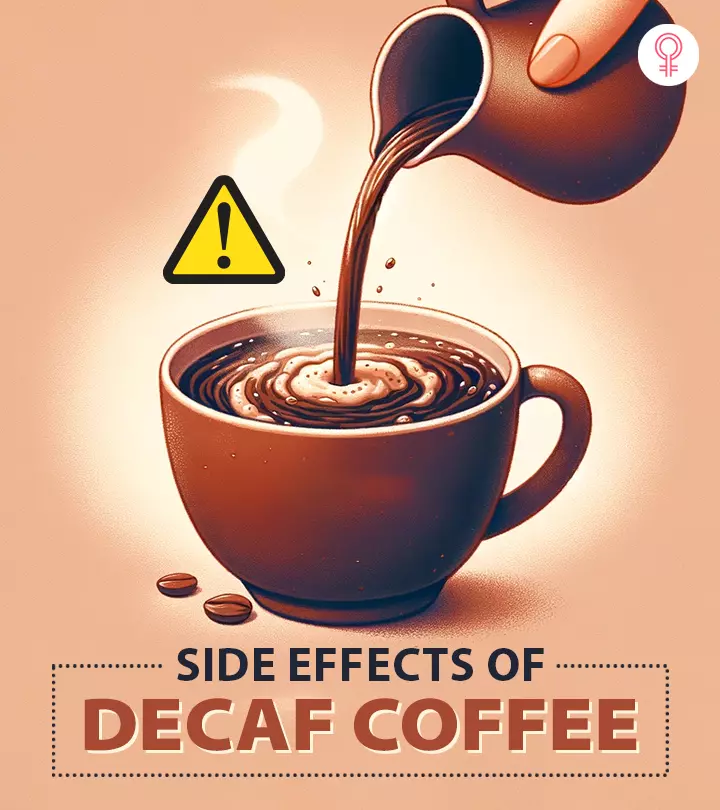

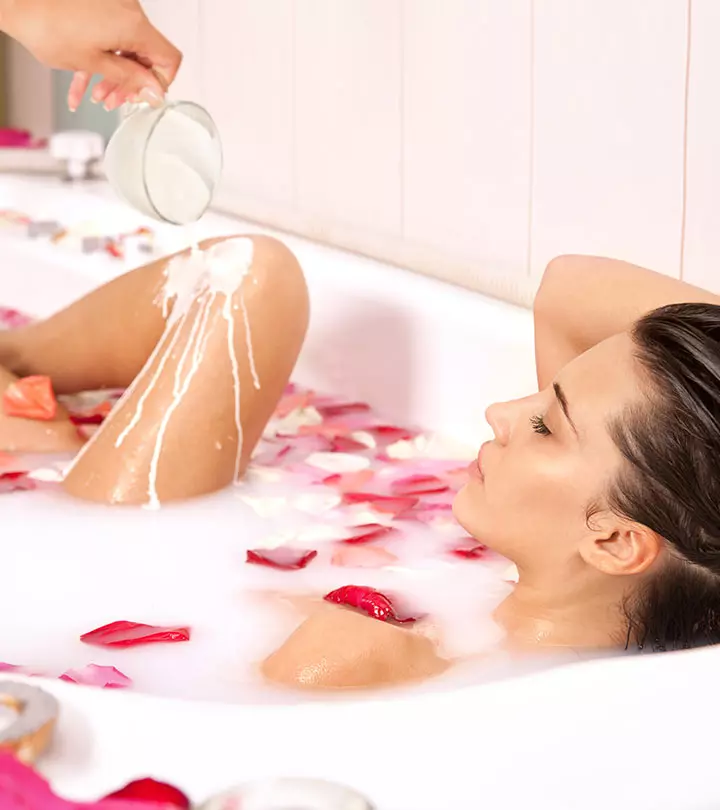


Community Experiences
Join the conversation and become a part of our empowering community! Share your stories, experiences, and insights to connect with other beauty, lifestyle, and health enthusiasts.